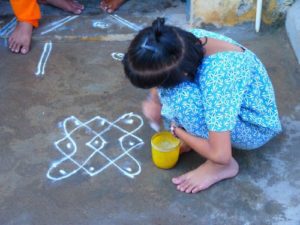
I love being a Protestant minister. I believe in the “priesthood of all believers” and I’m deeply committed to my own Presbyterian denomination’s way of doing things “decently and in order.” But now, in the midst of this pandemic, I am increasingly concerned that, as good as we are at some ways of being the church, mainline Protestants have not sufficiently prepared believers to be religious at home.
Domestic or family religious practice goes back a long way. For example, scholars can identify apparently religious artifacts at about 45% of the houses at Tell Beit Mirsim, a Judean site likely from the time of the Divided Monarchy. But these kinds of practices have also endured and can be seen all around us even today. The picture accompanying this article, for example, is of the Hindu ritual of kolam. Women in some parts of India arise daily before dawn to draw a design on their threshold using rice flour. These designs, some of which have been passed down from one generation to another, can be simple or complex, but they are always ephemeral, disappearing as the wind blows and the day progresses. They are made at the beginning of each day to honor or invite or thank the particular gods and goddesses of that household.
I’ve never been to India, and I mention kolam only because I love the idea of starting each day with the creation of something beautiful to honor the transcendent, but home religious practice is ubiquitous. I have seen icons covered with silver in the homes of Orthodox Christians in Russia. Here in Iowa, I’ve seen home altars of Catholic immigrants from Mexico and spaces set aside for daily meditation in the homes of American Buddhists. Many of us have Jewish or Muslim friends whose domestic religious practice involves special rules related to cooking.
Faith at home
Having ways to practice faith at home has left some traditions in a stronger position to respond to the pandemic. A friend from the Church of Jesus Christ of Latter-day Saints commented to me recently that the LDS church structure “is built for worshipping at home when needed.” As she explains it, because they are a global church with a global curriculum, their Sunday School manuals are the same everywhere and are translated into many languages. Since 2018, they have been emphasizing even more than usual a model of “home-centered, church-supported Gospel study,” in which every family is encouraged to use the Sunday School materials for daily family or individual study at home in preparation for in-person Sunday School. When all their churches had to shut down because of the pandemic, the in-person component of their religious practice was lost but the family component was strengthened. And of course, they started using Zoom!
For many mainline Protestants, however, these kinds of routine, embodied practices—drawing with rice flour or praying to an icon or spending holy time in a household sacred space—are not a common part of our experience. Except for rituals like hiding Easter eggs or putting up a Christmas tree (both only tangentially related to actual Christian beliefs), we do not often adapt our homes for sacred purposes. Even prayer and Bible study, which can be home-based but do not necessarily require special objects or spaces, happen less frequently in the homes of mainline Protestants than they do in the homes of other kinds of Christians. (According to the most recent Pew study (2014), 54% of mainline Protestants say they pray daily compared to 59% of Catholics, 79% of Evangelical Protestants, 80% of Historically Black Protestants, 85% of Mormons, and 90% of Jehovah’s Witnesses. 30% of mainline Protestants say they read the Bible daily compared to 25% of Catholics, 61% of Historically Black Protestants, 63% of Evangelical Protestants, 77% of Mormons, and 88% of Jehovah’s Witnesses.)
Leaving home to worship
Over time, our primary “practice” has become leaving home to worship. While there, our primary activity is sitting quietly while others, mostly professionals, lead us. And even this we do less frequently than others—33% of mainline Protestants are in church at least once a week, compared to 39% of Catholics, 53% of Historically Black Protestants, 58% of Evangelical Protestants, 77% of Mormons, and 85% of Jehovah’s Witnesses.
All of this has made surviving the pandemic particularly hard for many of the congregations where I work and worship. Members talk with increasing frustration about how much they miss hugs and handshakes and corporate singing (none of which are explicitly Christian practices), but most of us have few home-based religious practices to take their place. We’ve never had to experience long periods of time without the benefit of a paid professional and a separate congregational space, so we simply haven’t developed the “chops” to switch to home-based faith when the need arises.
Perhaps the pandemic provides a good opportunity for mainline Protestants to encourage home-made rituals. For me, these would always involve prayer and Bible study, because we cannot be a “priesthood of all believers” if we do not know what we believe. In addition, if we have anything to learn from our neighbors of other traditions, we need holy objects, sanctified time, and ritual movements with which to encounter God in a way that is not mediated by others and whose appropriate location is our own home space.
Sarai Rice is a Presbyterian minister and a retired non-profit executive. She consults with congregations on a variety of issues, including planning, staffing, and governance. Sarai loves to work with congregations that are exploring anew their role in the community as well as congregations seeking new energy in the face of decline. She has a deep commitment to the notion that human institutions should work well for the people they serve.
